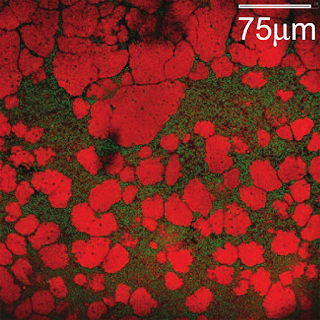Making these two groups of people work together was very difficult. Interdisciplinary science is hard. Scientists spend years or decades to understand enough a narrow field of knowledge to be able to make it progress. So when you put together scientists of different fields, they do not have the same vocabulary, the same methods, the same questions or the same expectations. When among physicists we were saying "We impose a constant shear stress" as a matter of fact, chemists were seeing us as
 |
| Physicist as seen by chemists |
 |
| Chemist as seen by physicists |
To understand what the chemists meant I had to remember my chemistry classes like 15 years ago. Fortunately I quite liked chemistry in undergrads. I even defined myself as a chemical physicist, a much needed missing transmission belt. I was able to play the role of translator between the two groups. What the chemists meant was that the ion was disturbing a lot the water around itself.
At the end, we were able to work together. We made mechanical experiments on samples that were about a millimetre thick and we understood the results at the level of atoms. Conversely, we used this chemical understanding to design the mechanical properties of our samples. Let me explain to you what we did, in terms that both my physicist and chemist colleagues are able to understand.
All started with a new synthesis method used by the chemists. Polymers are long molecules where the same unit is repeated many times, a bit like a caterpillar. To make polymers the chemists started from a head and added about 70 body segments one by one. Then they added the chemical groups they wanted to each unit, like if they added legs to every body segment.
Here they managed to have a head with two negative charges and each body segments with one positive charge. In water the polymer schematically looks like that:
 |
| A polymer were most of the counterions are far away. |
If you put that short linear polymer in pure water, it forms a very soft gel. Interestingly, you can inject it with a syringe. The gel is solid at rest, flows through the needle, and is solid again on the other side. Quite nice if you want to use a gel as a scaffold for cell growth in vivo. Nowadays, the gel is a soft solid that breaks irreversibly. You need a surgical procedure to put it in the body. With our type of gel a needle is enough.
Unfortunately for the applications, we found that our gel was very easily disturbed. If instead of pure water we used salty water the gel collapsed. If we started from a neutral head instead of the head bearing two minuses, no gel could form. Our mechanical measurements found no difference between the polymer solution and water alone. So we thought that the gel was formed due to charge interactions: minus head sticking to plus body. If no minus on the head, no gel. If salts, themselves charged, get in the way of the electrostatic attraction, no gel.
Also, something was quite strange: the gel was too soft. Like a thousand times too soft for such short polymers. A polymer gel is a 3D network whose edges are polymer chains and whose nodes are where chains meet, also called cross-links. The more meeting points you have, the harder the gel is. In other words, if you have short chains between cross-links, few body segments, the gel is hard. We measured the elasticity of the gel, and it was so soft that we predicted something like 60 000 body segments between meeting points! That is enough to make 880 of our short polymers!
 |
| Pine processionary caterpillars (source) |
So, we physicists were like "wow! that's strange" while the chemists were not caring much. Actually, the chemists were playing with their synthesis method to change the legs of the caterpillar.
| A polymer with complete counterion condensation. Probably insoluble. |
And indeed, we observed insolubility for the three compositions where the interaction between the repeated cation and its counterion was the strongest.
On the opposite, when the repeated cation and its counterion interacted weakly, we observed very strong gels, indicating shorter processions. Actually for two compositions we observed gels exactly 880 times stronger than the original one, meaning that the processions were just a single chain long.
So far so good, but all of this was learned by probing gently the softness of the gels, at deformations so low that they were not flowing but behaving as solids. To understand what is going on at larger strains, we have to have a look at the internal structure of a procession.
 |
| The procession at different scales. |
This cylinder does no grow in a straight line indefinitely. On scales large enough, counterions screen the charges from each other and the procession winds its way away.
 |
| Two charges in the mood for fight screened from each other by counterions. |
 |
| Each circle is a blob of momomers collapsed to avoid contact with water. |
For all compositions, the first threshold deformation is very small, telling us that the processions are almost linear at rest. It implies that the amount of charge condensation is directly related to the softness of the gel. So we are able to estimate charge condensation that varies from 10 free counterions per polymers (lots of charges) to one free counterion every 9 polymers in the procession (very few charges).
By contrast the second threshold vary widely between compositions between 10% and 800%. Some gels flow immediately, others need to be stretched height time their initial size before flowing. This indicates that the head to body bonds are incredibly strong. Usually in water ionic bonds are about 100 times weaker that chemical (covalent) bonds. For our lowest charge polymer we measure head to body bonds that are within 20% of the carbon-carbon bond!
Our explanation is that with few charges the procession collapse around the head-to-body bond to avoid water. So the environment just around the bond is not water, it's hydrophobic polymer. Such environment is like an oil, where charges are few but interact very strongly. Indeed in oils other people have measured ionic bonds that strong. Actually this strategy is used by life itself: proteins can have just one charge in the middle of a large hydrophobic patch. When two such proteins with opposite charges meet the two hydrophobic patched stick together, expelling water from the direct environment of the charged and the ionic bond become very strong. This forms a lock and key mechanism that helps for example our immune system to recognise and block pathogens.
Time to wrap up, thanks for reading down to here. At the end, we have done very standard mechanical measurements at the millimetre scale to extract informations at the chemical level. Our model tells us what to change to tune the mechanical properties of our gel by a factor thousand. Thanks to a referee, we also did a back of the envelope calculation to see what these gels would give in a physiological environment, and we have a good candidate to inject in a living body. If anybody is interested on the biology side...





